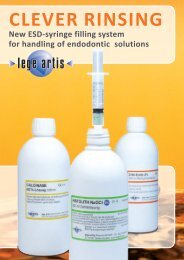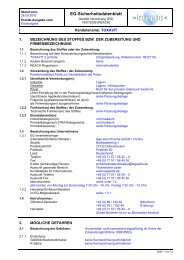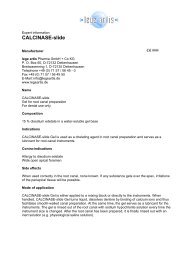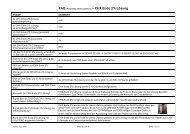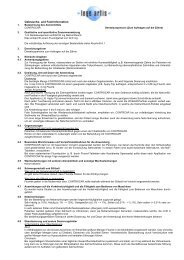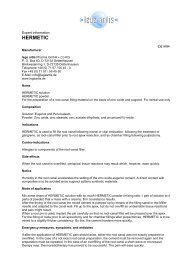Cp-CAP - Lege artis
Cp-CAP - Lege artis
Cp-CAP - Lege artis
You also want an ePaper? Increase the reach of your titles
YUMPU automatically turns print PDFs into web optimized ePapers that Google loves.
Expert information<br />
<strong>Cp</strong>-<strong>CAP</strong><br />
Manufacturer<br />
lege <strong>artis</strong> Pharma GmbH + Co KG<br />
P.O. Box 60, D-72132 Dettenhausen<br />
Breitwasenring 1, D-72135 Dettenhausen<br />
Telephone +49 (0) 71 57 / 56 45 - 0<br />
Fax +49 (0) 71 57 / 56 45 50<br />
E-Mail: info@lege<strong>artis</strong>.de<br />
www.lege<strong>artis</strong>.de<br />
Name<br />
<strong>Cp</strong>-<strong>CAP</strong> solution<br />
<strong>Cp</strong>-<strong>CAP</strong> powder<br />
For the preparation of a calcium hydroxide-containing zinc oxide-eugenol cement with a good<br />
radiographic contrast.<br />
For dental use only<br />
Composition<br />
Solution: Eugenol, colophony, Peru balsam<br />
Powder: Calcium hydroxide, zinc oxide, zinc acetate dihydrate, zirconium(IV)-oxide, and Canada<br />
balsam<br />
Indications<br />
<strong>Cp</strong>-<strong>CAP</strong> is used as pulp protection for the direct or indirect capping of the pulp and for the<br />
attachment of temporary measures following the preparation of vital stumps.<br />
Contra-indications<br />
If during the vitality test a clear pain on heat occurs (perhaps throbbing with the pulsation) a<br />
preservation of the vital tooth is no longer possible (pulpectomy, treatment of gangrene). Allergy to<br />
components of the cement, especially to eugenol and Peru balsam.<br />
Notice<br />
A direct contact with composites is to be avoided since eugenol softens synthetic materials.<br />
<strong>Cp</strong>-<strong>CAP</strong> powder contains calcium hydroxide. Avoid any contact with the eyes and the skin. In the<br />
case of unintentional contact with the eyes, remove the particles mechanically, if possible, then<br />
rinse immediately with plenty of water.<br />
Mode of application<br />
Stir one drop of <strong>Cp</strong>-<strong>CAP</strong> solution with as much <strong>Cp</strong>-<strong>CAP</strong> powder as possible, as thick as possible<br />
(mixing ratio 1 part of solution to 6 parts of powder), to give a firm consistency. Fill this mixture with<br />
the ball plugger into the cleaned and dry cavity.<br />
Cover first the marginal area of the cavity bottom and finally the central area which is nearest to the<br />
pulp. Fill mesial and distal cavities from top to bottom. Fill the cavity as completely as possible,<br />
then remove as much of the hardened <strong>Cp</strong>-<strong>CAP</strong> as is necessary for the final filling.
Cave: Before the application of composites cover the <strong>Cp</strong>-<strong>CAP</strong> with a protective layer of phosphate<br />
cement (eugenol!).<br />
To avoid pulpal pain following the preparation of vital stumps, temporary measures can be<br />
attached with <strong>Cp</strong>-<strong>CAP</strong>.<br />
Further notices<br />
<strong>Cp</strong>-<strong>CAP</strong> combines the properties of calcium hydroxide with those of zinc oxide-eugenol cement.<br />
Zinc oxide and eugenol form the matrix of the cement.<br />
Zinc acetate serves as accelerator. By its adhesive power Canada balsam causes the cement to<br />
adhere well in the cavity and to form a dense structure. Peru balsam acts like a softener so that the<br />
cement will not become too short and crumbly. Zirconium(IV)-oxide imparts a very good<br />
radiographic contrast to <strong>Cp</strong>-<strong>CAP</strong>.<br />
Calcium hydroxide acts strongly alkaline (ca pH 12) and produces a superficial coagulation<br />
necrosis on the vital tissue. As a defensive reaction this coagulation necrosis induces the formation<br />
of a mineralised barrier towards the pulp, and after about 3 months a closed repair dentine layer<br />
(bridging tertiary dentine) can develop.<br />
<strong>Cp</strong>-<strong>CAP</strong> sets in 40 - 220 seconds. Raised air humidity or raised temperatures influence the setting<br />
time. Raised temperatures lead to a reduction and the uptake of air humidity to a prolongation of<br />
the setting time.<br />
Do not put back remainders of the powder into the container.<br />
Shelf life<br />
<strong>Cp</strong>-<strong>CAP</strong> solution and <strong>Cp</strong>-<strong>CAP</strong> powder shall not be used after the expiry date.<br />
Storage and preservation<br />
Always store <strong>Cp</strong>-<strong>CAP</strong> powder in airtight containers.<br />
Administrative form and package size<br />
5 ml solution<br />
15 g powder<br />
Date of revision<br />
January 2010<br />
Symbol of “Expiry date” Symbol of “Batch number”<br />
Symbol of “Pay attention to the directions for use”<br />
0026303/Stückzahl0110/Bestelldatum




